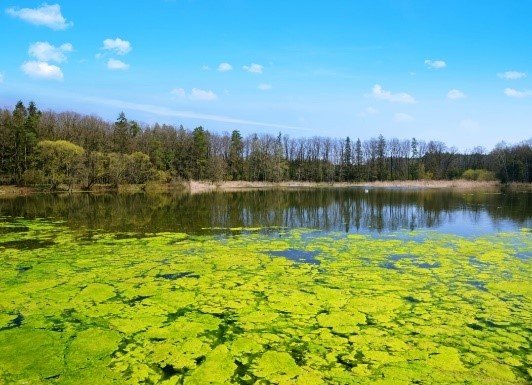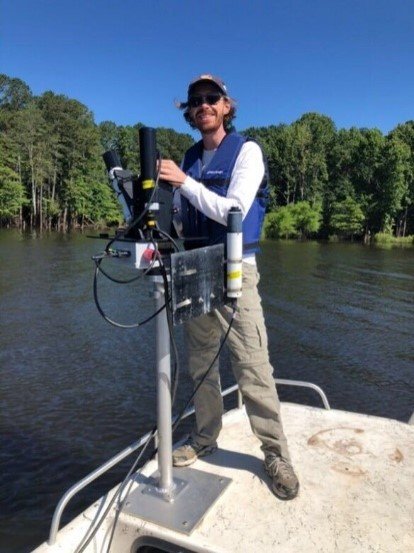EPA Researchers Develop Forecasting Approach to Predict Harmful Cyanobacterial Blooms for U.S. Lakes
Published January 23, 2024; Updated July 23, 2024

Freshwater cyanobacteria are found in all lakes and reservoirs, are naturally occurring, and are important to water ecosystems; however, excessive growth of some cyanobacteria can result in harmful cyanobacterial blooms (HCBs, also called cyanobacterial harmful algal blooms or cyanoHABs). These blooms can cause unsightly scums that smell like rotting eggs or septic. Toxins from HCBs can negatively impact people, animals, and the environment. Exposure to these toxins may occur through recreational activities, like swimming and boating, drinking water, irrigation, and they can affect livestock and fisheries. Cyanobacterial biomass can result in water taste and odor issues in drinking water, hypoxia (dead zones), reduced aquatic diversity and even socio-economic impacts such as rising healthcare costs and diminished real estate value.
Due to climate and land use pressures, there is concern that HCBs may increase in frequency, extent, and magnitude, but it can be difficult to know when and where HCBs may form. In response, EPA scientists Blake Schaeffer, Wilson Salls, Deron Smith, John Johnston, Mark Myer, and former Oak Ridge Institute for Science and Education (ORISE) participants Natalie Reynolds and Hannah Ferriby developed a scientific approach for forecasting freshwater HCBs using satellite data. This approach was the first of its kind to successfully forecast high-risk HCB events across 2,192 of the largest lakes in the contiguous U.S. This model provides advanced notice of potential harmful blooms through weekly probability forecasts, and a beta test is available to the public from July to November 2024.
“There is a lot of ongoing research to forecast HCBs at small scales for lakes, but the novelty of this approach is that it does so at such a broad spatial scale,” said Wilson Salls, an EPA environmental scientist.
The approach will be especially useful to water quality managers and public health professionals looking for additional tools to improve proactive measures. These timely forecasts can be used to complement regular sampling or observation methods.

“Our research may be one of the first times that we are examining and predicting water quality analogous to weather forecasting,” said Blake Schaeffer, an EPA research scientist.
The researchers applied Bayesian modeling, which is a probabilistic statistical method, in combination with satellite monitoring data from the Cyanobacteria Assessment Network (CyAN) and a set of simple environmental predictor variables to estimate the probability of a cyanobacterial bloom occurring in a given week. The prediction results were compared against the actual cyanobacteria presence observed in satellite data, and the model’s overall prediction accuracy was 90%.
“This research provides a tool that uses a large dataset of past HCB information from satellite imagery, and predictors such as lake morphology, lake temperature, and precipitation, to deliver a good prediction of future HCB events,” said Mark Myer, an EPA risk assessor.
Through November 2024, the team’s beta model provided the public with weekly forecasts for 2,192 lakes. EPA staff ran the model to generate probabilities of cyanoHABs and posted the forecasting results on the Cyanobacterial Harmful Algal Blooms Forecasting Research webpage.
This work is in direct response to The Harmful Algal Bloom and Hypoxia Research and Control Amendments Act, which requires EPA to advance the scientific understanding and ability to detect, monitor, assess, and predict HAB and hypoxia events in freshwater across the U.S.
“CyAN gave us a powerful tool to provide the monitoring and many of our state and Tribal partners rely on that tool. The new model delivers on the forecasting side and the approach will help those same partners get ahead of blooms and provide better protection for human health and the environment,” said Michael Paul, EPA's National HABs Program lead.
Schaeffer presented this work at the first HABs, Hypoxia, and Nutrients Research Webinar on January 31, 2024. You can watch the recording here.
Related Resources
- Cyanobacterial Harmful Algal Blooms Forecasting Research
- Read the journal article: Forecasting freshwater cyanobacterial harmful algal blooms for Sentinel-3 satellite resolved U.S. lakes and reservoirs
- EPA’s Harmful Algal Blooms Research
- Registration for the HABs, Hypoxia, and Nutrients Research Webinar Series
- Cyanobacteria Assessment Network (CyAN)
- Science Matters Story on “American Possibilities: A White House Demo Day”
- Read “Spatio-Temporal Modeling for Forecasting High-Risk Freshwater Cyanobacterial Harmful Algal Blooms in Florida”

